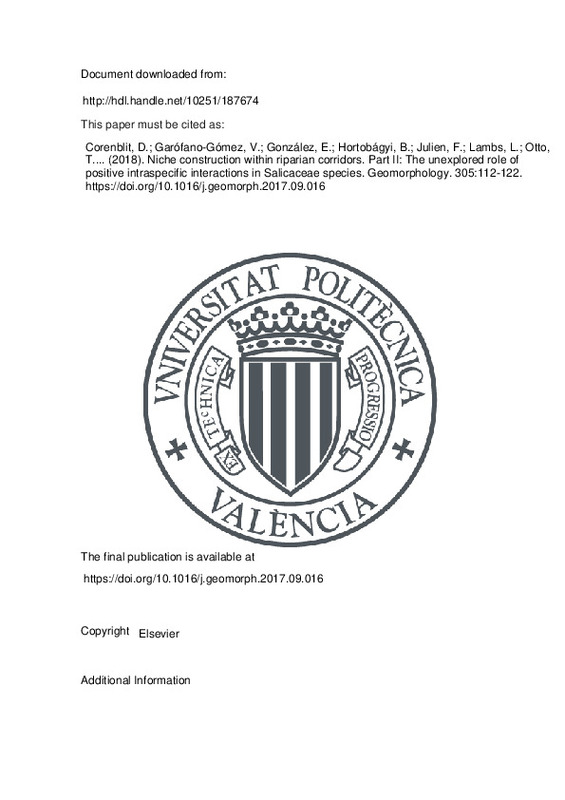JavaScript is disabled for your browser. Some features of this site may not work without it.
Buscar en RiuNet
Listar
Mi cuenta
Estadísticas
Ayuda RiuNet
Admin. UPV
Niche construction within riparian corridors. Part II: The unexplored role of positive intraspecific interactions in Salicaceae species
Mostrar el registro sencillo del ítem
Ficheros en el ítem
| dc.contributor.author | Corenblit, Dov
|
es_ES |
| dc.contributor.author | Garófano-Gómez, Virginia
|
es_ES |
| dc.contributor.author | González, Eduardo
|
es_ES |
| dc.contributor.author | Hortobágyi, Borbála
|
es_ES |
| dc.contributor.author | Julien, Frédéric
|
es_ES |
| dc.contributor.author | Lambs, Luc
|
es_ES |
| dc.contributor.author | Otto, Thierry
|
es_ES |
| dc.contributor.author | Roussel, Erwan
|
es_ES |
| dc.contributor.author | Steiger, Johannes
|
es_ES |
| dc.contributor.author | Tabacchi, Eric
|
es_ES |
| dc.contributor.author | Till-Bottraud, Irène
|
es_ES |
| dc.date.accessioned | 2022-10-13T18:06:51Z | |
| dc.date.available | 2022-10-13T18:06:51Z | |
| dc.date.issued | 2018-03-15 | es_ES |
| dc.identifier.issn | 0169-555X | es_ES |
| dc.identifier.uri | http://hdl.handle.net/10251/187674 | |
| dc.description.abstract | [EN] Within riparian corridors, Salicaceae trees and shrubs affect hydrogeomorphic processes and lead to the formation of wooded fluvial landforms. These trees form dense stands and enhance plant anchorage, as grouped plants are less prone to be uprooted than free-standing individuals. This also enhances their role as ecosystem engineers through the trapping of sediment, organic matter, and nutrients. The landform formation caused by these wooded biogeomorphic landforms probably represents a positive niche construction, which ultimately leads, through facilitative processes, to an improved capacity of the individual trees to survive, exploit resources, and reach sexual maturity in the interval between destructive floods. The facilitative effects of riparian vegetation are well established; however, the nature and intensity of biotic interactions among trees of the same species forming dense woody stands and constructing the niche remain unclear. Our hypothesis is that the niche construction process also comprises more direct intraspecific interactions, such as cooperation or altruism. Our aim in this paper is to propose an original theoretical framework for positive intraspecific interactions among riparian Salicaceae species operating from establishment to sexual maturity. Within this framework, we speculate that (i) positive intraspecific interactions among trees are maximized in dynamic river reaches; (ii) during establishment, intraspecific facilitation (or helping) occurs among trees and this leads to the maintenance of a dense stand that improves survival and growth because saplings protect each other from shear stress and scour; (iii) in addition to the improved capacity to trap mineral and organic matter, individuals that constitute the dense stand can cooperate to mutually support a mycorrhizal network that will connect plants, soil, and groundwater and influence nutrient transfer, cycling, and storage within the shared constructed niche; (iv) during post-establishment, roots form functional grafts between neighbouring trees to increase biomechanical and physiological anchorage as well as nutrient acquisition and exchange; and (v) these stands remain dense on alluvial bars until a threshold of landform construction and hydrogeomorphic disconnection is reached. At this last stage, intraspecific competition for resources (light and nutrients) increases, inducing a density reduction in the aerial stand (i.e., self-thinning), but root systems of altruistic individuals could remain functional via root grafting. Finally, we suggest new methodological perspectives for testing our hypotheses related to the occurrence of positive intraspecific interactions among Salicaceae trees in fluvial landform and niche construction through in situ and ex situ experiments. | es_ES |
| dc.description.sponsorship | During the development of the ideas proposed in this article, Dov Corenblit had a chaire d'excellence position at the French National Research Centre (CNRS); Virginia Garafano-Gomez had a post-doctoral grant from the Universite Blaise Pascal (now: Universite Clermont Auvergne, Clermont-Ferrand, France), and Borbala Hortobagyi received funding for her Ph.D. (contrat de recherche) from the French Ministry of National Education, Higher Education and Research. We thank S. Luhmann-Steiger for helping us with the English editing, and the editors, D. Butler and It Marston, for handling our manuscript and their feedback. | es_ES |
| dc.language | Inglés | es_ES |
| dc.publisher | Elsevier | es_ES |
| dc.relation.ispartof | Geomorphology | es_ES |
| dc.rights | Reconocimiento - No comercial - Sin obra derivada (by-nc-nd) | es_ES |
| dc.subject | Biogeomorphology | es_ES |
| dc.subject | Mycorrhiza | es_ES |
| dc.subject | Root grafting | es_ES |
| dc.subject | Positive biotic interactions | es_ES |
| dc.title | Niche construction within riparian corridors. Part II: The unexplored role of positive intraspecific interactions in Salicaceae species | es_ES |
| dc.type | Artículo | es_ES |
| dc.identifier.doi | 10.1016/j.geomorph.2017.09.016 | es_ES |
| dc.rights.accessRights | Abierto | es_ES |
| dc.contributor.affiliation | Universitat Politècnica de València. Instituto de Investigación para la Gestión Integral de Zonas Costeras - Institut d'Investigació per a la Gestió Integral de Zones Costaneres | es_ES |
| dc.description.bibliographicCitation | Corenblit, D.; Garófano-Gómez, V.; González, E.; Hortobágyi, B.; Julien, F.; Lambs, L.; Otto, T.... (2018). Niche construction within riparian corridors. Part II: The unexplored role of positive intraspecific interactions in Salicaceae species. Geomorphology. 305:112-122. https://doi.org/10.1016/j.geomorph.2017.09.016 | es_ES |
| dc.description.accrualMethod | S | es_ES |
| dc.relation.publisherversion | https://doi.org/10.1016/j.geomorph.2017.09.016 | es_ES |
| dc.description.upvformatpinicio | 112 | es_ES |
| dc.description.upvformatpfin | 122 | es_ES |
| dc.type.version | info:eu-repo/semantics/publishedVersion | es_ES |
| dc.description.volume | 305 | es_ES |
| dc.relation.pasarela | S\462144 | es_ES |







![[Cerrado]](/themes/UPV/images/candado.png)

